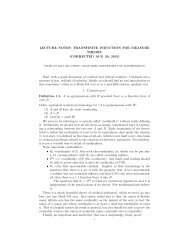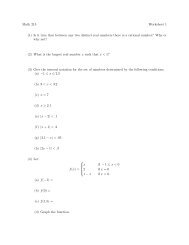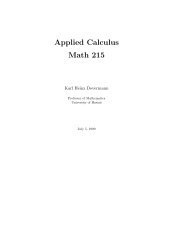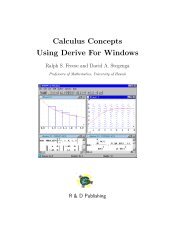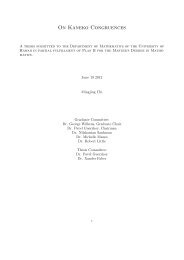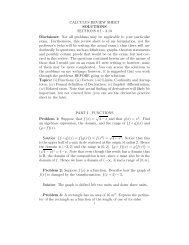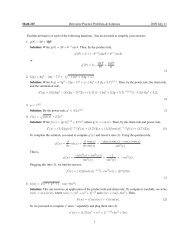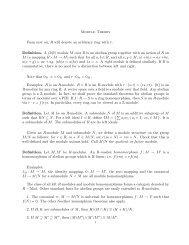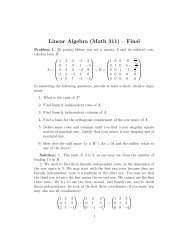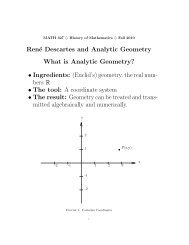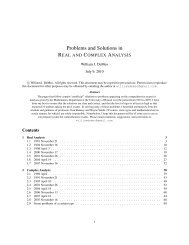Multiple Solutions for a Nonlinear Dirichlet Problem via - Mathematics
Multiple Solutions for a Nonlinear Dirichlet Problem via - Mathematics
Multiple Solutions for a Nonlinear Dirichlet Problem via - Mathematics
You also want an ePaper? Increase the reach of your titles
YUMPU automatically turns print PDFs into web optimized ePapers that Google loves.
MULTIPLE SOLUTIONS FOR A NONLINEAR DIRICHLET<br />
PROBLEM VIA MORSE INDEX<br />
Jorge Cossio ∗<br />
Universidad Nacional de Colombia<br />
Alfonso Castro<br />
Harvey Mudd College, USA<br />
Carlos Velez<br />
Universidad Nacional de Colombia<br />
Hawaii, April 2008
In this lecture we study the nonlinear <strong>Dirichlet</strong> problem<br />
� Δu + f (u) = 0 in Ω,<br />
u = 0 on ∂Ω,<br />
MULTIPLE SOLUTIONS FOR A NONLINEAR DIRICHLET PROBLEM VIA MORSE INDEX – 2➲<br />
▲ ▲<br />
(0.1)<br />
➲ ❏ ✘
In this lecture we study the nonlinear <strong>Dirichlet</strong> problem<br />
� Δu + f (u) = 0 in Ω,<br />
u = 0 on ∂Ω,<br />
where Δ is the Laplacian operator, Ω ⊂ R N is a bounded region with<br />
MULTIPLE SOLUTIONS FOR A NONLINEAR DIRICHLET PROBLEM VIA MORSE INDEX – 3➲<br />
▲ ▲<br />
(0.1)<br />
smooth boundary, and f : R → R is a function of class C 1 asymptotically<br />
linear, i.e.<br />
.<br />
f ′ (∞) := lím<br />
|t|→∞ f ′ (t) ∈ R.<br />
➲ ❏ ✘
Let λ1,λ2,λ3,... be the sequence of eigenvalues of −Δ in Ω with zero<br />
<strong>Dirichlet</strong> boundary condition.<br />
MULTIPLE SOLUTIONS FOR A NONLINEAR DIRICHLET PROBLEM VIA MORSE INDEX – 4➲<br />
▲ ▲<br />
➲ ❏ ✘
Let λ1,λ2,λ3,... be the sequence of eigenvalues of −Δ in Ω with zero<br />
<strong>Dirichlet</strong> boundary condition.<br />
As it is well known, to solve (0.1) is equivalent to find critical points of the<br />
functional J : H 1 0<br />
where F(ξ) = � ξ<br />
0<br />
(Ω) → R defined by<br />
� �<br />
1<br />
J(u) =<br />
2 |∇u|2 �<br />
− F(u)<br />
f (s) ds.<br />
Ω<br />
MULTIPLE SOLUTIONS FOR A NONLINEAR DIRICHLET PROBLEM VIA MORSE INDEX – 5➲<br />
dx, (0.2)<br />
▲ ▲<br />
➲ ❏ ✘
Throughout this paper we assume f satisfies the following hypotheses:<br />
(f1) f (0) = 0 and f ′ (0) < λ1,<br />
(f2) f ′ (∞) ∈ (λk,λk+1),<br />
(f3) There is a constant γ such that f ′ (t) ≤ γ < λk+1 <strong>for</strong> every t ∈ R.<br />
Under these conditions that we are assuming on f , J ∈ C 2 .<br />
MULTIPLE SOLUTIONS FOR A NONLINEAR DIRICHLET PROBLEM VIA MORSE INDEX – 6➲<br />
▲ ▲<br />
➲ ❏ ✘
Throughout this paper we assume f satisfies the following hypotheses:<br />
(f1) f (0) = 0 and f ′ (0) < λ1,<br />
(f2) f ′ (∞) ∈ (λk,λk+1),<br />
(f3) There is a constant γ such that f ′ (t) ≤ γ < λk+1 <strong>for</strong> every t ∈ R.<br />
Under these conditions that we are assuming on f , J ∈ C 2 .<br />
We recall that if u is a critical point of J and there exists a maximal<br />
integer q such that D 2 J(u) is negative definite on some q-dimensional<br />
subspace then the Morse index m(u,J) of u is q.<br />
MULTIPLE SOLUTIONS FOR A NONLINEAR DIRICHLET PROBLEM VIA MORSE INDEX – 7➲<br />
▲ ▲<br />
➲ ❏ ✘
Theorem A. If f satisfies (f1), (f2), (f3), k ≥ 4 is an even number, and all<br />
the solutions of (0.1) are nondegenerate then problem (0.1)<br />
has at least five solutions: u1 = 0, u2 > 0 in Ω, u3 < 0 in Ω, u4, and u5.<br />
Moreover,<br />
MULTIPLE SOLUTIONS FOR A NONLINEAR DIRICHLET PROBLEM VIA MORSE INDEX – 8➲<br />
▲ ▲<br />
➲ ❏ ✘
Theorem A. If f satisfies (f1), (f2), (f3), k ≥ 4 is an even number, and all<br />
the solutions of (0.1) are nondegenerate then problem (0.1)<br />
has at least five solutions: u1 = 0, u2 > 0 in Ω, u3 < 0 in Ω, u4, and u5.<br />
Moreover,<br />
(a) m(u4,J) = k.<br />
MULTIPLE SOLUTIONS FOR A NONLINEAR DIRICHLET PROBLEM VIA MORSE INDEX – 9➲<br />
▲ ▲<br />
➲ ❏ ✘
Theorem A. If f satisfies (f1), (f2), (f3), k ≥ 4 is an even number, and all<br />
the solutions of (0.1) are nondegenerate then problem (0.1)<br />
has at least five solutions: u1 = 0, u2 > 0 in Ω, u3 < 0 in Ω, u4, and u5.<br />
Moreover,<br />
(a) m(u4,J) = k.<br />
(b) u5 changes sign, m(u5,J) is even and m(u5,J) ≤ k.<br />
MULTIPLE SOLUTIONS FOR A NONLINEAR DIRICHLET PROBLEM VIA MORSE INDEX – 10➲<br />
▲ ▲<br />
➲ ❏ ✘
Theorem A. If f satisfies (f1), (f2), (f3), k ≥ 4 is an even number, and all<br />
the solutions of (0.1) are nondegenerate then problem (0.1)<br />
has at least five solutions: u1 = 0, u2 > 0 in Ω, u3 < 0 in Ω, u4, and u5.<br />
Moreover,<br />
(a) m(u4,J) = k.<br />
(b) u5 changes sign, m(u5,J) is even and m(u5,J) ≤ k.<br />
(c) If m(u5,J) = k, there are two additional solutions u6 and u7 of (0.1).<br />
Moreover m(u6,J) = k − 1.<br />
MULTIPLE SOLUTIONS FOR A NONLINEAR DIRICHLET PROBLEM VIA MORSE INDEX – 11➲<br />
▲ ▲<br />
➲ ❏ ✘
Theorem A. If f satisfies (f1), (f2), (f3), k ≥ 4 is an even number, and all<br />
the solutions of (0.1) are nondegenerate then problem (0.1)<br />
has at least five solutions: u1 = 0, u2 > 0 in Ω, u3 < 0 in Ω, u4, and u5.<br />
Moreover,<br />
(a) m(u4,J) = k.<br />
(b) u5 changes sign, m(u5,J) is even and m(u5,J) ≤ k.<br />
(c) If m(u5,J) = k, there are two additional solutions u6 and u7 of (0.1).<br />
Moreover m(u6,J) = k − 1.<br />
(d) If u4 is of one sign, there are also two additional solutions u6 and u7<br />
of (0.1).<br />
MULTIPLE SOLUTIONS FOR A NONLINEAR DIRICHLET PROBLEM VIA MORSE INDEX – 12➲<br />
▲ ▲<br />
➲ ❏ ✘
REMARK:<br />
We prove the existence of u2 and u3 using mountain pass arguments of<br />
the Ambrosetti-Rabinowitz type.<br />
MULTIPLE SOLUTIONS FOR A NONLINEAR DIRICHLET PROBLEM VIA MORSE INDEX – 13➲<br />
▲ ▲<br />
➲ ❏ ✘
REMARK:<br />
We prove the existence of u2 and u3 using mountain pass arguments of<br />
the Ambrosetti-Rabinowitz type.<br />
We show the existence of u4 by using Lyapunov-Schmidt arguments to<br />
reduce the solvability of (0.1) to a finite dimensional problem.<br />
MULTIPLE SOLUTIONS FOR A NONLINEAR DIRICHLET PROBLEM VIA MORSE INDEX – 14➲<br />
▲ ▲<br />
➲ ❏ ✘
REMARK:<br />
We prove the existence of u2 and u3 using mountain pass arguments of<br />
the Ambrosetti-Rabinowitz type.<br />
We show the existence of u4 by using Lyapunov-Schmidt arguments to<br />
reduce the solvability of (0.1) to a finite dimensional problem.<br />
We use degree theory to show the existence of u5.<br />
MULTIPLE SOLUTIONS FOR A NONLINEAR DIRICHLET PROBLEM VIA MORSE INDEX – 15➲<br />
▲ ▲<br />
➲ ❏ ✘
Sketch of the Proof of Theorem A:<br />
Because of (f1), u1 ≡ 0 is a strict local minimum of J, so<br />
dloc(∇J,u1) = 1.<br />
MULTIPLE SOLUTIONS FOR A NONLINEAR DIRICHLET PROBLEM VIA MORSE INDEX – 16➲<br />
▲ ▲<br />
➲ ❏ ✘
Sketch of the Proof of Theorem A:<br />
Because of (f1), u1 ≡ 0 is a strict local minimum of J, so<br />
dloc(∇J,u1) = 1.<br />
The existence of the two signed-solutions u2 > 0 in Ω and u3 < 0 in Ω is<br />
proved by using the Mountain Pass Theorem. Moreover,<br />
dloc(∇J,u2) = dloc(∇J,u3) = −1, (0.3)<br />
MULTIPLE SOLUTIONS FOR A NONLINEAR DIRICHLET PROBLEM VIA MORSE INDEX – 17➲<br />
▲ ▲<br />
➲ ❏ ✘
Sketch of the Proof of Theorem A:<br />
Also, if S2 (resp. S3) is a region that contains all the positive (resp.<br />
negative) solutions of (0.1) and no one else, Castro and Cossio proved<br />
that<br />
d(∇J,S2,0) = −1 = d(∇J,S3,0). (0.4)<br />
Since f ′ (∞) is not an eigenvalue of −Δ, it can be shown that there exists<br />
an R > 0 such that BR(0) contains all the critical points of J, and<br />
d(∇J,BR(0),0) = (−1) k . (0.5)<br />
MULTIPLE SOLUTIONS FOR A NONLINEAR DIRICHLET PROBLEM VIA MORSE INDEX – 18➲<br />
▲ ▲<br />
➲ ❏ ✘
Sketch of the Proof of Theorem A:<br />
Lemma 1. (the Lyapunov-Schmidt reduction method)<br />
Let H be a real separable Hilbert space. Let X and Y be closed<br />
subspaces of H such that H = X ⊕Y . Let J : H → R be a functional of<br />
class C 2 . If there are m > 0 and α > 1 such that<br />
〈∇J(x + y) − ∇J(x + y1),y − y1〉 ≥ m�y − y1� α<br />
MULTIPLE SOLUTIONS FOR A NONLINEAR DIRICHLET PROBLEM VIA MORSE INDEX – 19➲<br />
<strong>for</strong> all x ∈ X, y, y1 ∈ Y<br />
▲ ▲<br />
(0.6)<br />
➲ ❏ ✘
Sketch of the Proof of Theorem A:<br />
Lemma 1. (the Lyapunov-Schmidt reduction method)<br />
Let H be a real separable Hilbert space. Let X and Y be closed<br />
subspaces of H such that H = X ⊕Y . Let J : H → R be a functional of<br />
class C 2 . If there are m > 0 and α > 1 such that<br />
〈∇J(x + y) − ∇J(x + y1),y − y1〉 ≥ m�y − y1� α<br />
then:<br />
There exists a C 1 function ψ : X → Y such that<br />
J(x + ψ(x)) = mín<br />
y∈Y<br />
J(x + y).<br />
MULTIPLE SOLUTIONS FOR A NONLINEAR DIRICHLET PROBLEM VIA MORSE INDEX – 20➲<br />
<strong>for</strong> all x ∈ X, y, y1 ∈ Y<br />
▲ ▲<br />
(0.6)<br />
➲ ❏ ✘
Sketch of the Proof of Theorem A:<br />
The function ˆ<br />
J : X → R defined by ˆ<br />
J(x) = J(x + ψ(x)) is of class C 2 .<br />
MULTIPLE SOLUTIONS FOR A NONLINEAR DIRICHLET PROBLEM VIA MORSE INDEX – 21➲<br />
▲ ▲<br />
➲ ❏ ✘
Sketch of the Proof of Theorem A:<br />
The function ˆ<br />
J : X → R defined by ˆ<br />
J(x) = J(x + ψ(x)) is of class C 2 .<br />
An element x0 ∈ X is a critical point of ˆ<br />
J if and only if x0 + ψ(x0) ∈ H is a<br />
critical point of J.<br />
MULTIPLE SOLUTIONS FOR A NONLINEAR DIRICHLET PROBLEM VIA MORSE INDEX – 22➲<br />
▲ ▲<br />
➲ ❏ ✘
Sketch of the Proof of Theorem A:<br />
The function ˆ<br />
J : X → R defined by ˆ<br />
J(x) = J(x + ψ(x)) is of class C 2 .<br />
An element x0 ∈ X is a critical point of ˆ<br />
J if and only if x0 + ψ(x0) ∈ H is a<br />
critical point of J.<br />
Moreover,<br />
dloc(∇J,x0 + ψ(x0)) = dloc(∇ ˆ<br />
J,x0). (0.7)<br />
m(u0,J) = m(x0, ˆ<br />
J). (0.8)<br />
MULTIPLE SOLUTIONS FOR A NONLINEAR DIRICHLET PROBLEM VIA MORSE INDEX – 23➲<br />
▲ ▲<br />
➲ ❏ ✘
Sketch of the Proof of Theorem A:<br />
Let X be the subspace of H spanned by {ϕ1,ϕ2,...,ϕk } and let<br />
Y := X ⊥ , thus H = X ⊕Y. Since J ∈ C 2 (H,R), there is a constant γ<br />
such that f ′ (t) ≤ γ < λk+1 <strong>for</strong> every t ∈ R, and<br />
〈∇J(u),v〉 =<br />
it follows that<br />
�<br />
(∇u · ∇v − f (u)v) dx, ∀u,v ∈ H<br />
Ω<br />
1 0 (Ω), (0.9)<br />
〈∇J(x + y) − ∇J(x + y1),y − y1〉 ≥ m�y − y1� 2<br />
MULTIPLE SOLUTIONS FOR A NONLINEAR DIRICHLET PROBLEM VIA MORSE INDEX – 24➲<br />
<strong>for</strong> all x ∈ X, y, y1 ∈ Y<br />
▲ ▲<br />
(0.10)<br />
➲ ❏ ✘
Sketch of the Proof of Theorem A:<br />
Let X be the subspace of H spanned by {ϕ1,ϕ2,...,ϕk } and let<br />
Y := X ⊥ , thus H = X ⊕Y. Since J ∈ C 2 (H,R), there is a constant γ<br />
such that f ′ (t) ≤ γ < λk+1 <strong>for</strong> every t ∈ R, and<br />
〈∇J(u),v〉 =<br />
it follows that<br />
�<br />
(∇u · ∇v − f (u)v) dx, ∀u,v ∈ H<br />
Ω<br />
1 0 (Ω), (0.9)<br />
〈∇J(x + y) − ∇J(x + y1),y − y1〉 ≥ m�y − y1� 2<br />
MULTIPLE SOLUTIONS FOR A NONLINEAR DIRICHLET PROBLEM VIA MORSE INDEX – 25➲<br />
<strong>for</strong> all x ∈ X, y, y1 ∈ Y<br />
then, by Lemma 1 There exists a C 1 function ψ : X → Y such that<br />
J(x + ψ(x)) = mín<br />
y∈Y<br />
J(x + y).<br />
▲ ▲<br />
(0.10)<br />
➲ ❏ ✘
Sketch of the Proof of Theorem A:<br />
Let X be the subspace of H spanned by {ϕ1,ϕ2,...,ϕk } and let<br />
Y := X ⊥ , thus H = X ⊕Y. Since J ∈ C 2 (H,R), there is a constant γ<br />
such that f ′ (t) ≤ γ < λk+1 <strong>for</strong> every t ∈ R, and<br />
〈∇J(u),v〉 =<br />
it follows that<br />
�<br />
(∇u · ∇v − f (u)v) dx, ∀u,v ∈ H<br />
Ω<br />
1 0 (Ω), (0.9)<br />
〈∇J(x + y) − ∇J(x + y1),y − y1〉 ≥ m�y − y1� 2<br />
MULTIPLE SOLUTIONS FOR A NONLINEAR DIRICHLET PROBLEM VIA MORSE INDEX – 26➲<br />
<strong>for</strong> all x ∈ X, y, y1 ∈ Y<br />
then, by Lemma 1 There exists a C 1 function ψ : X → Y such that<br />
J(x + ψ(x)) = mín<br />
y∈Y<br />
J(x + y).<br />
▲ ▲<br />
(0.10)<br />
➲ ❏ ✘
Sketch of the Proof of Theorem A:<br />
The function ˆ<br />
J : X → R defined by ˆ<br />
J(x) = J(x + ψ(x)) is of class C 2 , and<br />
x0 ∈ X is a critical point of ˆ<br />
J if and only if x0 + ψ(x0) ∈ H is a critical<br />
point of J.<br />
MULTIPLE SOLUTIONS FOR A NONLINEAR DIRICHLET PROBLEM VIA MORSE INDEX – 27➲<br />
▲ ▲<br />
➲ ❏ ✘
Sketch of the Proof of Theorem A:<br />
The function ˆ<br />
J : X → R defined by ˆ<br />
J(x) = J(x + ψ(x)) is of class C 2 , and<br />
x0 ∈ X is a critical point of ˆ<br />
J if and only if x0 + ψ(x0) ∈ H is a critical<br />
point of J.<br />
Because f ′ (∞) ∈ (λk,λk+1) it follows that<br />
ˆ<br />
J(x) → −∞ as �x� → ∞ <strong>for</strong> x ∈ X. (0.11)<br />
MULTIPLE SOLUTIONS FOR A NONLINEAR DIRICHLET PROBLEM VIA MORSE INDEX – 28➲<br />
▲ ▲<br />
➲ ❏ ✘
Sketch of the Proof of Theorem A:<br />
The function ˆ<br />
J : X → R defined by ˆ<br />
J(x) = J(x + ψ(x)) is of class C 2 , and<br />
x0 ∈ X is a critical point of ˆ<br />
J if and only if x0 + ψ(x0) ∈ H is a critical<br />
point of J.<br />
Because f ′ (∞) ∈ (λk,λk+1) it follows that<br />
ˆ<br />
J(x) → −∞ as �x� → ∞ <strong>for</strong> x ∈ X. (0.11)<br />
Because dimX < ∞, there exists x4 ∈ X such that<br />
J(x4) ˆ = máxJ.<br />
ˆ<br />
X<br />
MULTIPLE SOLUTIONS FOR A NONLINEAR DIRICHLET PROBLEM VIA MORSE INDEX – 29➲<br />
▲ ▲<br />
➲ ❏ ✘
Sketch of the Proof of Theorem A:<br />
The function ˆ<br />
J : X → R defined by ˆ<br />
J(x) = J(x + ψ(x)) is of class C 2 , and<br />
x0 ∈ X is a critical point of ˆ<br />
J if and only if x0 + ψ(x0) ∈ H is a critical<br />
point of J.<br />
Because f ′ (∞) ∈ (λk,λk+1) it follows that<br />
ˆ<br />
J(x) → −∞ as �x� → ∞ <strong>for</strong> x ∈ X. (0.11)<br />
Because dimX < ∞, there exists x4 ∈ X such that<br />
J(x4) ˆ = máxJ.<br />
ˆ<br />
X<br />
Hence, u4 = x4 + ψ(x4) is a critical point of J.<br />
MULTIPLE SOLUTIONS FOR A NONLINEAR DIRICHLET PROBLEM VIA MORSE INDEX – 30➲<br />
▲ ▲<br />
➲ ❏ ✘
Sketch of the Proof of Theorem A:<br />
The function ˆ<br />
J : X → R defined by ˆ<br />
J(x) = J(x + ψ(x)) is of class C 2 , and<br />
x0 ∈ X is a critical point of ˆ<br />
J if and only if x0 + ψ(x0) ∈ H is a critical<br />
point of J.<br />
Because f ′ (∞) ∈ (λk,λk+1) it follows that<br />
ˆ<br />
J(x) → −∞ as �x� → ∞ <strong>for</strong> x ∈ X. (0.11)<br />
Because dimX < ∞, there exists x4 ∈ X such that<br />
J(x4) ˆ = máxJ.<br />
ˆ<br />
X<br />
Hence, u4 = x4 + ψ(x4) is a critical point of J.<br />
MULTIPLE SOLUTIONS FOR A NONLINEAR DIRICHLET PROBLEM VIA MORSE INDEX – 31➲<br />
▲ ▲<br />
➲ ❏ ✘
Sketch of the Proof of Theorem A:<br />
Observe that x4 is a point of minimum of − ˆ<br />
J. Thus, dloc(∇(− ˆ<br />
J),x4) = 1<br />
and dloc(∇ ˆ<br />
J,x4) = (−1) k .<br />
MULTIPLE SOLUTIONS FOR A NONLINEAR DIRICHLET PROBLEM VIA MORSE INDEX – 32➲<br />
▲ ▲<br />
➲ ❏ ✘
Sketch of the Proof of Theorem A:<br />
Observe that x4 is a point of minimum of − ˆ<br />
J. Thus, dloc(∇(− ˆ<br />
J),x4) = 1<br />
and dloc(∇ ˆ<br />
J,x4) = (−1) k .<br />
In virtue of (0.7),<br />
dloc(∇J,u4) = (−1) k = 1. (0.12)<br />
MULTIPLE SOLUTIONS FOR A NONLINEAR DIRICHLET PROBLEM VIA MORSE INDEX – 33➲<br />
▲ ▲<br />
➲ ❏ ✘
Sketch of the Proof of Theorem A:<br />
Observe that x4 is a point of minimum of − ˆ<br />
J. Thus, dloc(∇(− ˆ<br />
J),x4) = 1<br />
and dloc(∇ ˆ<br />
J,x4) = (−1) k .<br />
In virtue of (0.7),<br />
dloc(∇J,u4) = (−1) k = 1. (0.12)<br />
Now, because of our hypothesis of nondegeneracy of critical points of J<br />
and the characterization of x4, m(x4, ˆ<br />
J) = k. Lemma 1 implies that<br />
m(u4,J) = k and we have proved part (a) of Theorem A.<br />
MULTIPLE SOLUTIONS FOR A NONLINEAR DIRICHLET PROBLEM VIA MORSE INDEX – 34➲<br />
▲ ▲<br />
➲ ❏ ✘
Sketch of the Proof of Theorem A:<br />
Let K be the set of critical points of J. Let S1, S2, S3 be disjoint open<br />
bounded regions in H such that S1 ∩ K = {u1}, S2 ∩ K is the set of<br />
positive solutions of (1), and S3 ∩ K is the set of negative solutions of<br />
(0.1). We consider two cases, which will lead us to prove (b) and (d) of<br />
Theorem A.<br />
MULTIPLE SOLUTIONS FOR A NONLINEAR DIRICHLET PROBLEM VIA MORSE INDEX – 35➲<br />
▲ ▲<br />
➲ ❏ ✘
Sketch of the Proof of Theorem A:<br />
Suppose first that u4 changes sign. Let S4 be an open bounded region<br />
disjoint from S1 ∪ S2 ∪ S3 such that S4 ∩ K = {u4}. Then, because of<br />
(0.4), (0.5), (0.12) and the excision property of Leray-Schauder degree,<br />
(−1) k = d(∇J,BR(0),0)<br />
= d(∇J,S1,0) + d(∇J,S2,0) + d(∇J,S3,0) + d(∇J,S4,0)<br />
+ d(∇J,BR(0) \ S1 ∪ S2 ∪ S3 ∪ S4,0)<br />
= 1 − 1 − 1 + 1 + d(∇J,BR(0) \ S1 ∪ S2 ∪ S3 ∪ S4,0).<br />
MULTIPLE SOLUTIONS FOR A NONLINEAR DIRICHLET PROBLEM VIA MORSE INDEX – 36➲<br />
▲ ▲<br />
➲ ❏ ✘
Sketch of the Proof of Theorem A:<br />
Suppose first that u4 changes sign. Let S4 be an open bounded region<br />
disjoint from S1 ∪ S2 ∪ S3 such that S4 ∩ K = {u4}. Then, because of<br />
(0.4), (0.5), (0.12) and the excision property of Leray-Schauder degree,<br />
(−1) k = d(∇J,BR(0),0)<br />
= d(∇J,S1,0) + d(∇J,S2,0) + d(∇J,S3,0) + d(∇J,S4,0)<br />
+ d(∇J,BR(0) \ S1 ∪ S2 ∪ S3 ∪ S4,0)<br />
= 1 − 1 − 1 + 1 + d(∇J,BR(0) \ S1 ∪ S2 ∪ S3 ∪ S4,0).<br />
There<strong>for</strong>e, d(∇J,BR(0) \ S1 ∪ S2 ∪ S3 ∪ S4,0) = 1.<br />
MULTIPLE SOLUTIONS FOR A NONLINEAR DIRICHLET PROBLEM VIA MORSE INDEX – 37➲<br />
▲ ▲<br />
➲ ❏ ✘
Sketch of the Proof of Theorem A:<br />
Consequently, there must exist another critical point u5 of J whose local<br />
degree is<br />
1 = (−1) m(u5,J) .<br />
MULTIPLE SOLUTIONS FOR A NONLINEAR DIRICHLET PROBLEM VIA MORSE INDEX – 38➲<br />
▲ ▲<br />
➲ ❏ ✘
Sketch of the Proof of Theorem A:<br />
Consequently, there must exist another critical point u5 of J whose local<br />
degree is<br />
Thus, m(u5,J) is even.<br />
1 = (−1) m(u5,J) .<br />
MULTIPLE SOLUTIONS FOR A NONLINEAR DIRICHLET PROBLEM VIA MORSE INDEX – 39➲<br />
▲ ▲<br />
➲ ❏ ✘
Sketch of the Proof of Theorem A:<br />
Consequently, there must exist another critical point u5 of J whose local<br />
degree is<br />
Thus, m(u5,J) is even.<br />
Since<br />
〈D 2 J(u)y,y〉 ≥ (1 − γ<br />
1 = (−1) m(u5,J) .<br />
λk+1<br />
)�y� 2 ; ∀u ∈ H ∀y ∈ Y. (0.13)<br />
it follows that m(u5,J) ≤ k. Observe that u5 is a sign-changing solution of<br />
(0.1). This prove Theorem A part (b).<br />
MULTIPLE SOLUTIONS FOR A NONLINEAR DIRICHLET PROBLEM VIA MORSE INDEX – 40➲<br />
▲ ▲<br />
➲ ❏ ✘
Sketch of the Proof of Theorem A:<br />
Now suppose u4 is of one sign. Without loss of generality we can<br />
assume u4 ∈ S2. Let P be a subregion of S2 such that P ∩ K = {u2,u4}.<br />
From (0.3), (0.4), (0.12) and the excision property of Leray-Schauder<br />
degree it follows that<br />
−1 = d(∇J,S2,0)<br />
= dloc(∇J,u2) + dloc(∇J,u4) + d(∇J,S2 \ P,0)<br />
= −1 + (−1) k + d(∇J,S2 \ P,0).<br />
Hence, the existence property of the Leray-Schauder degree implies<br />
there must be another signed solution of (0.1).<br />
MULTIPLE SOLUTIONS FOR A NONLINEAR DIRICHLET PROBLEM VIA MORSE INDEX – 41➲<br />
▲ ▲<br />
➲ ❏ ✘
Sketch of the Proof of Theorem A:<br />
Let us denote by u5 this solution. Arguing as in the case in which u4<br />
changes sign, one can get the existence of u6 and u7 which are<br />
sign-changing solutions of (0.1). We have completed the proof of (b) and<br />
(d) in Theorem A.<br />
MULTIPLE SOLUTIONS FOR A NONLINEAR DIRICHLET PROBLEM VIA MORSE INDEX – 42➲<br />
▲ ▲<br />
➲ ❏ ✘
Sketch of the Proof of Theorem A:<br />
We finally prove (c). Let us suppose m(u5,J) = k. Writing u5 as<br />
u5 = x5 + ψ(x5), Lemma 1 asserts that m(x5, J) ˆ = k and so x5 is a local<br />
maximum of J.<br />
ˆ<br />
MULTIPLE SOLUTIONS FOR A NONLINEAR DIRICHLET PROBLEM VIA MORSE INDEX – 43➲<br />
▲ ▲<br />
➲ ❏ ✘
Sketch of the Proof of Theorem A:<br />
We finally prove (c). Let us suppose m(u5,J) = k. Writing u5 as<br />
u5 = x5 + ψ(x5), Lemma 1 asserts that m(x5, J) ˆ = k and so x5 is a local<br />
maximum of J. ˆ<br />
Thus, x4 and x5 are points of minima of − ˆ<br />
J. The Mountain Pass<br />
Theorem implies that there exists a critical point x6 of the mountain pass<br />
type <strong>for</strong> −J. ˆ<br />
MULTIPLE SOLUTIONS FOR A NONLINEAR DIRICHLET PROBLEM VIA MORSE INDEX – 44➲<br />
▲ ▲<br />
➲ ❏ ✘
Sketch of the Proof of Theorem A:<br />
We finally prove (c). Let us suppose m(u5,J) = k. Writing u5 as<br />
u5 = x5 + ψ(x5), Lemma 1 asserts that m(x5, J) ˆ = k and so x5 is a local<br />
maximum of J. ˆ<br />
Thus, x4 and x5 are points of minima of − ˆ<br />
J. The Mountain Pass<br />
Theorem implies that there exists a critical point x6 of the mountain pass<br />
type <strong>for</strong> −J. ˆ<br />
Because of nondegeneracy, m(x6,− ˆ<br />
J) = 1 (see [Hofer]). Hence,<br />
m(x6, ˆ<br />
J) = k − 1. Again, by Lemma 1 u6 = x6 + ψ(x6) is a critical point of<br />
J whose Morse index is k − 1. Finally, using a degree counting, as<br />
be<strong>for</strong>e, we get u7. In this way we got (c), and our proof is complete. �<br />
MULTIPLE SOLUTIONS FOR A NONLINEAR DIRICHLET PROBLEM VIA MORSE INDEX – 45➲<br />
▲ ▲<br />
➲ ❏ ✘
References<br />
Referencias<br />
[1] A. Castro and J. Cossio, <strong>Multiple</strong> <strong>Solutions</strong> <strong>for</strong> a <strong>Nonlinear</strong> <strong>Dirichlet</strong><br />
<strong>Problem</strong>, SIAM J. Math. Anal., Vol. 25 (1994), 1554-1561.<br />
[2] A. Castro, J. Cossio, and J. M. Neuberger, A Sign-Changing<br />
Solution <strong>for</strong> a Superlinear <strong>Dirichlet</strong> <strong>Problem</strong>, Rocky Mountain J.<br />
Math., Vol. 27, 4 (1997), 1041-1053.<br />
[3] A. Castro, J. Cossio, and J. M. Neuberger, On <strong>Multiple</strong> <strong>Solutions</strong> of<br />
a <strong>Nonlinear</strong> <strong>Dirichlet</strong> <strong>Problem</strong>, <strong>Nonlinear</strong> Analysis, Vol. 30, 6 (1997),<br />
3657-3662.<br />
[4] A. Castro and A. C. Lazer, Critical Point Theory and the Number of<br />
➲ ❏ ✘<br />
MULTIPLE SOLUTIONS FOR A NONLINEAR DIRICHLET PROBLEM VIA MORSE INDEX – 46➲<br />
▲ ▲
References<br />
<strong>Solutions</strong> of a <strong>Nonlinear</strong> <strong>Dirichlet</strong> <strong>Problem</strong>, Ann. Mat. Pura Appl.,<br />
Vol. 70, No. 4 (1979), pp. 113-137.<br />
[5] J. Cossio and S. Herrón, Nontri<strong>via</strong>l <strong>Solutions</strong> <strong>for</strong> a Semilinear<br />
<strong>Dirichlet</strong> <strong>Problem</strong> with <strong>Nonlinear</strong>ity Crossing <strong>Multiple</strong> Eigenvalues,<br />
Journal of Dynamics and Differential Equations, Vol. 16, No. 3, July<br />
2004, 795-803.<br />
[6] J. Cossio and C. Vélez, Soluciones no Tri<strong>via</strong>les para un <strong>Problem</strong>a<br />
de <strong>Dirichlet</strong> Asintóticamente Lineal, Rev. Colombiana Mat., Vol. 37,<br />
No. 1, (2003), 25-36.<br />
[7] H. Hofer, The Topological Degree at a Critical Point of Mountain<br />
Pass Type, Proc. Sympos. Pure Math., Vol. 45, (1986), 501-509.<br />
➲ ❏ ✘<br />
MULTIPLE SOLUTIONS FOR A NONLINEAR DIRICHLET PROBLEM VIA MORSE INDEX – 47➲<br />
▲ ▲
References<br />
[8] P. Rabinowitz, Minimax Methods in Critical Point Theory with<br />
Applications to Differential Equations, Regional Conference Series<br />
in <strong>Mathematics</strong>, 65, Providence, R.I., AMS (1986).<br />
MULTIPLE SOLUTIONS FOR A NONLINEAR DIRICHLET PROBLEM VIA MORSE INDEX – 48➲<br />
▲ ▲<br />
➲ ❏ ✘
Fin<br />
Copyright c○ 2008<br />
Jorge Cossio ∗<br />
Universidad Nacional de Colombia<br />
Alfonso Castro<br />
Harvey Mudd College, USA<br />
Carlos Velez<br />
Universidad Nacional de Colombia<br />
Realizada con ujislides c○ 2002-3 Sergio Barrachina (barrachi@icc.uji.es)




